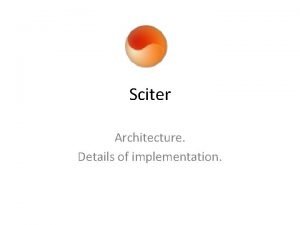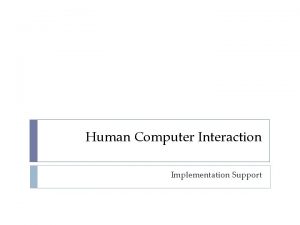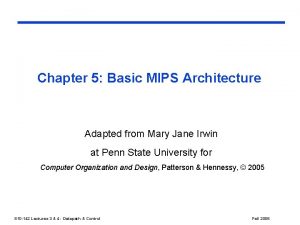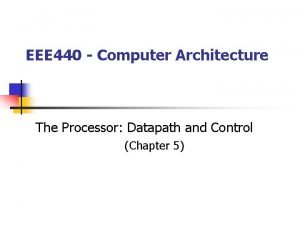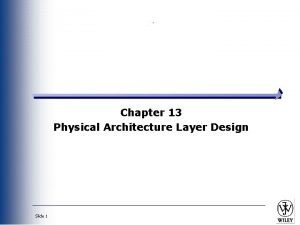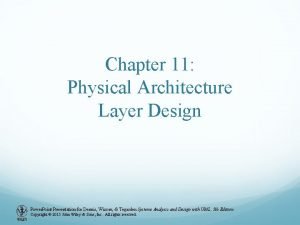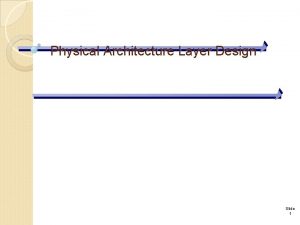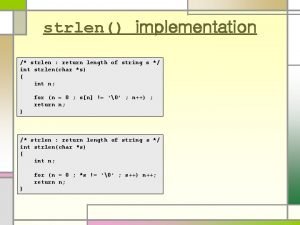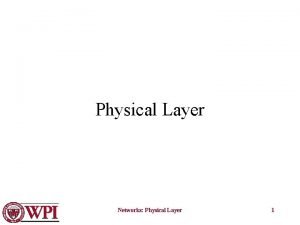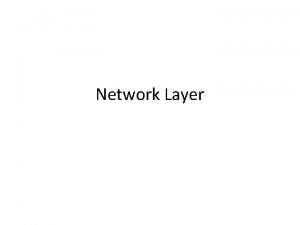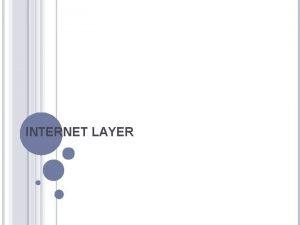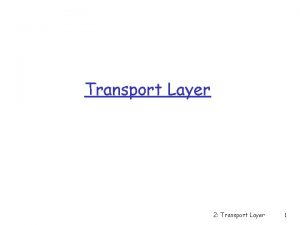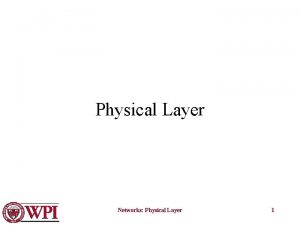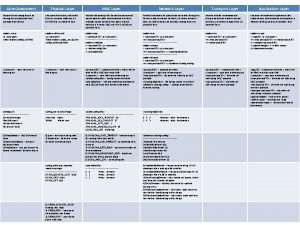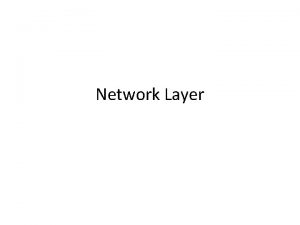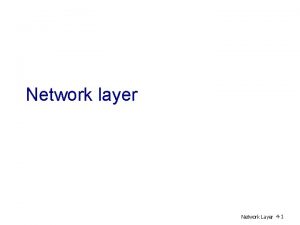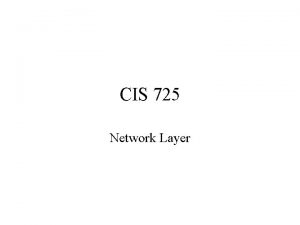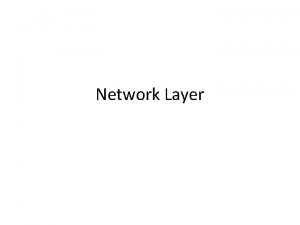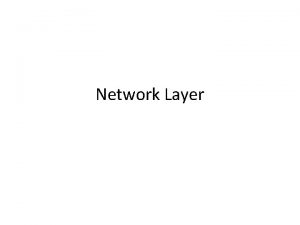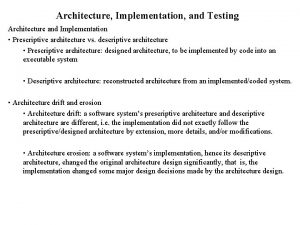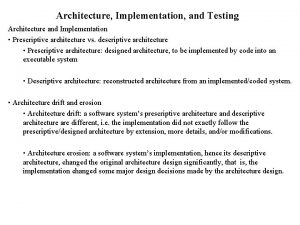Sciter Architecture Details of implementation Sciter UI layer








































- Slides: 40

Sciter Architecture. Details of implementation.

Sciter – UI layer of the application • Separation of concerns principle, UI: – Objects lifecycle: complex ownership graph with loops. – Tend to change in lifetime of the application. – Subject of style changes and customization. • Must be isolated from backend. • UI <-> backend API shall be compact and stable.

Sciter Architecture • Major Sciter modules: 1. 2. 3. 4. 5. HTML: parser/compiler and DOM tree; CSS: parser/compiler and CSS OM; Layout module; Script: source-to-bytecode compiler, VM, runtime classes: Array, Object, String, … Graphics, Windowing/Desktop and system back ends;

Source code sturcture • • • batch engine gtk – linux/gtk osx – Mac. OS xgl – win, lin, mac – Skia incl. Open. GL • sdk • engine – tool – gool – html – tiscript – xdom – d 2 d, gdi+ – external • jpeg, png, webp, zlib • uv – lib. UV - async I/O – win – api – res

Sciter. Threading model • Sciter is mostly single threaded – UI code and scripts run solely in GUI thread; – Multiple GUI threads supported but a) not required and b) not recommended. • Sciter may use worker (non-GUI) threads internally: – HTTP communication; – lib. UV: Sockets, Pipes, File I/O (threads or completion ports). • Sciter API is thread safe but involves marshalling of call parameters into GUI thread. • Call of long-running native methods: function find. Threats() { function when. Found(data) { //. . . update UI by data. . . } // starts worker thread and returns immediately view. long. Running(when. Found); }

HTML DOM tree HTML source: <html> <head> <script>…</script> <style>…</style> </head> <body> <header>…</header> <main> Hello World </main> <footer>…</footer> </body> </html>

Document loading sequence • Parse input HTML – elements created and pushed into DOM tree; – <style> elements are parsed as they inserted into DOM tree; – At the end: DOM tree is compete, style tables are there. • Compile and run scripts in <script> elements – Handle include "other. tis"; while running. • Resolve styles of all elements – Load images for background-image: url(…); – Handle behavior: ”…” and prototype: ”…” – behaviors assignment. May involve running script code of attached() methods. • Do layout of visible elements in the window – May involve running script code of element. on. Size() methods. • Render all visible elements

HTML DOM • List of classes – Node – Text: Node – Comment: Node – Element: Node – Document: Element – View (a. k. a. window) • DOM tree: – View contains single root document element. – Document contains tree of its children.

HTML DOM. Node and Element namespace html { struct node : resource { weak_handle<element> parent; // DOM parent weak_handle<element> owner; // rendering parent uint node_index; uint 64 obj; // script object }; struct text : node {. . . }; struct comment : node {. . . }; struct element : node { uint tag; attribute_bag atts; ui_state; // <img> // <img src="url"> // : active, : focus, : hover array<handle<node>> nodes; // children handle<style> handle<ctl> handle<animation> handle<layout_data> }; } c_style, p_style; behavior; animator; ldata;

HTML DOM. Document • Document is <html> element – root of the DOM tree. It also contains resource and style collections. namespace html { struct document : element { weak_handle<view> view; image_bag style_bag images; styles; handle<application> app; uint 64 ns; // script namespace object }; }

CSS • CSS is parsed into: – Flat table of • selector/struct style pairs • ordered by the selector specificity

namespace html { struct style : resource { enum_v display; enum_v visibility; string font_name; size_v font_size; . . . }; struct style_def selector handle<style> uint }; CSS internals { selector; style; specicity() const; // of selector struct style_bag { tool: : pool<hstyle> resolved_pool; // interned styles tool: : array<hstyle_def>> defs; // ordered in specificity() order }; }

CSS. Style resolution. • To find styles of DOM elements: • • Each DOM element is tested against each style selector. If selector matches the style then properties of the style rule are applied. • The complexity of style resolution is O(N*S) where: • • N – number of DOM elements; S – number of style rules; for each (var element in document) { style_to_find; for each ( var style_def in document. styles ) if (element. match(style_def. selector)) { style_to_find. update(style_def. style); } element. current_style = document. intern(style_to_find); }

CSS. Style resolution. Optimization • Engine does sibling style optimization: – Previous sibling with resolved style is tested against “similarity”: • Has same set of attributes and state flags • Has same number of children, etc. – If previous sibling matches then its resolved style is used for the element. – Note: use of : nth-child() selector breaks this optimization.

Layout Step I • Compute min/max intrinsic sizes Hello world Hello universe Hello Symantec Hello Los Angeles

Layout Step II • Compute min/max intrinsic sizes • Setup widths – will give us heights Hello world Hello universe Hello Symantec Hello Los Angeles

Layout Step III • Compute min/max intrinsic sizes • Setup widths – will give us heights • Adjust vertical alignment and positions. Hello world Hello universe Hello Symantec Hello Los Angeles

Complexity of layout computation • At least O(N) complex, N is a number of DOM elements involved. • Dynamic updates and property animations: small change of the DOM may lead to deep tree layout computation. – Solutions: • Minimize number of elements involved, or: • CSS transform animations – no relayout; • Opacity animations – no relayout.

DOM Population, Complexity • Parsing (performed as a single transaction): Element. html = "html string"; Element. content("html string"); • Batch (array) population (single transaction) Element. content([el 1, el 2, …]); //. append()/. prepend • Single element insertion/deletion (worst case – O(n 2) if it is done in a loop) Element. append(el); //. insert()/. prepend After each external mutation, the DOM must be in consistent state. Check for consistency can be expensive. Possible solution: Reactor/SSX*

Events. Dispatching • Two phases of event delivering: – “Sinking” – from parent to child – “Bubbling” – from child to parent • Events can be “consumed” in any phase – return true; from an event handler; • Container can: – intercept events of children – postprocess events of children

DOM. Behavior • Behavior is a named event handler attached to DOM element. – Can be native – Or in script as a class • Native behaviors attachment is defined by CSS property “behavior”: toolbar > button { behavior: clickable; } • The behavior CSS property assigns native event handlers that are declared in engine core or in code of host application. • Close analogy: HWND == HELEMENT, behavior == Win. Proc + struct • Supports concept of value: element. value = 2;

DOM. Native behavior • Attached to an element. Responsible for event handling, value, can perform custom drawing and provide “methods” for script: struct ctl: event_handler { virtual bool on(view &v, virtual bool on(view &v, element element *self, *self, event_mouse &evt); event_key &evt); event_focus &evt); event_command &evt); event_scroll &evt); event_behavior &evt); event_exchange &evt); event_gesture &evt); virtual bool set_value(view &v, element *self, const value &val); virtual bool get_value(view &v, element *self, value &val); virtual bool draw_foreground(view &v, element *self, graphics *sf, point pos); draw_background(view &v, element *self, graphics *sf, point pos); draw_content(view &v, element *self, graphics *sf, point pos); draw_outline(view &v, element *self, graphics *sf, point pos); virtual bool on_x_method_call(view &v, element *self, const char *name, const value *argv, size_t argc, value &retval); };

DOM. Built-in behaviors Basic buttons Edits clickable button checkbox radio & switch edit password masked-edit numeric integer decimal textarea richtext Selects dropdown-select dropdown-multi-select-multiple select-checkmarks tree-view tree-checkmarks Date/time calendar date time Output/indicators output • text • integer • decimal • currency • date-local • time-local progress scrollbar slider image shellicon filethumbnail style-bag HTML behaviors Auxiliary frame history frame-set form hyperlink htmlarea expandable-list collapsible-list swipe marquee column-resizer Menu menu-bar menu popup-selector

Scripting behaviors & event handlers • Classes: CSS (declarative) assignment: class My. Button : Element { event click(event) { … } event keyup(event) { … } } • Aspects: function My. Button() { this << event click { … }; } • Explicit event handlers: var some. El = …; some. El << event click { … }; span. my-button { prototype: My. Button url(buttons. tis); } span. my-button { aspect: My. Button url(buttons. tis); }

Sciter Script: TIScript • Mostly Java. Script and has: – Compiler, producing bytecodes. – Virtual machine executing those bytecodes – Heap manager that uses compacting copying GC. • Extended by: – Classes, namespaces, decorators, persistent storage, streams and “UI types”. • Integrated with DOM, GC.

Sciter script: data types • • • Numeric: integer, float Collections: array, map (object) String and Symbol Boolean: true and false Tuple (tagged array) Stream (file, in-memory string buffer) Bytes – vector of bytes. Persistent data: Storage and Index Length: 1 dip, 2 px, 1 em (CSS support type) Angle: 1 grad, 3 rad, 1 turn (CSS support type) Duration: 1 s, 400 ms (CSS support type)

Script: namespaces • Namespaces are declared by using the namespace keyword. They can contain classes, functions, variables, and constants: namespace Threats { var threat. List = []; function add(threat) { threat. List. push(threat); } } Threats. add(found. Threat); // calling function in namespace Message { // enum like namespace const WARNING = 1; const ERROR = 2; const CRITICAL_ERROR = 3; } var msg. Type = Message. ERROR;

Script: Classes, constructors, and properties

namespace tis { class VM { value array<value> value* Script VM val; stack; sp; // current value register // execution stack // stack top pointer // script heap, two "halves" Cs. Memory. Space *old. Space; // old memory space Cs. Memory. Space *new. Space; // new memory space value* value value. . . }; } bytecodes; pc; ns; method. Object; vector. Object; string. Object; integer. Object; // // // bytecodes of current function // current bytecode position // namespace of current function obj obj for for the the Method type Vector type String type Integer type

Script VM: value namespace tis { typedef uint 64 value; } • tis: : value can store inplace: – float number ( a. k. a. cpp: : double – 64 bit ); – integer number – 32 bit signed integer; – symbols including true|false|undefined|null; • reference types (as 32 bit or 48 bit pointer): – Objects, classes and namespaces; – Arrays; – Strings;

Script VM: value packaging • IEEE 754 double-precision floating-point number. double type is 64 -bit, comprised of 1 sign bit, 11 exponent bits and 52 mantissa bits: 7 6 5 4 3 2 1 0 seeeeeee | eeeemmmm | mmmmmmmm | mmmmmmmm • “Not-a-number” double value is when exponent is 111111. So all other values are: 7 6 5 4 3 2 1 0 1111 | 1111 tttt | vvvvvvvv | vvvvvvvv Na. N marker |type | 48 -bit placeholder for values: pointers, strings

Script VM. Object struct object { value prototype; // a. k. a. class value properties; // list of properties or hash map int property. Count; value observer; // list of observers unsigned flags; }; Calling object methods: obj. zap(); // found locally, // this === obj. clear(); // found in prototype chain // this === obj

Script VM: bytecodes • Bytecode: value in range 0. . 255 • Instruction for VM - similar to code instruction fro i 386 processor “machine”. #define #define #define #define BC_NOP 0 x 00 BC_BRT 0 x 01 BC_BRF 0 x 02 BC_BR 0 x 03 BC_T 0 x 04 BC_NULL 0 x 05 BC_PUSH 0 x 06 BC_NOT 0 x 07 BC_ADD 0 x 08 BC_SUB 0 x 09 BC_MUL 0 x 0 a BC_DIV 0 x 0 b BC_REM 0 x 0 c BC_BAND 0 x 0 d. . . /* /* /* /* NOP */ branch on true */ branch on false */ branch unconditionally */ load val with true */ load val with null */ push val onto stack */ logical negate top of stack */ add two numeric expressions */ subtract two numeric expressions */ multiply two numeric expressions */ divide two numeric expressions */ remainder of two numeric expressions */ bitwise and of top two stack entries */

Script compiler • Translates sequence of tokens into sequence of bytecodes: var a = 1 + 2; BC_LITERAL 1 BC_PUSH BC_LITERAL 2 BC_ADD BC_STORE A // // // vm. val <- integer(1) vm. stack. push(vm. val) vm. val <- integer(2) vm. val <- vm. stack. pop() + vm. val heap_variable('A') <- vm. val • Bytecodes are stored in function objects: struct method : public object /* method is an Object! */ { value code; // bytecodes value ns; // namespace };

Script VM: execution • To run a function: a) setup VM by function bytecodes and b) execute them: bool Exec: : run(VM *c, …) /* Execute - execute bytecodes */ { while (c->pc < c->bytecodes. end()) { switch (*c->pc++) { case BC_NOP: break; case BC_RETURN: if (last) return true; break; case BC_BRT: . . . ; break; case BC_BRF: . . . ; break; case BC_BR: . . . ; break; case BC_NULL: c->val = NULL_VALUE; break; case BC_PUSH: Cs. Push(c, c->val); break; case BC_NOT: c->val = Cs. To. Boolean(c, c->val) ? FALSE_VALUE : TRUE_VALUE; break; case BC_ADD: c->val = Binary. Op(c, BC_ADD, Cs. Pop(c), c->val); break; . . . } } }

Script VM: heap and GC Copying GC: • Contains two equal “halves”; • On heap overflow copies content of one half into another; • Compacts memory while copying.

Window/View • Wraps HWINDOW – platform specific window; • Holds root document; • Holds reference to VM that is shared among all windows in the thread class view : public virtual resource, public iwindow, public event_handler, public pump { virtual HWINDOW get_hwnd() = 0; virtual graphics* surface() = 0; } // HWND, NSWindow, Gtk. Window // provides surface graphics handle<document> pdoc; // root document array<posted_event> array<handle<functor>> array<timer_def> posted_events; // element. post. Event(. . . ) posted_functors; // element. post( function(){. . . }) element_timers; array<handle<iwindow>> windows; // popup, tool and child windows // scripting handle<tis: : vm> tis: : value vm; view_obj; // holds script VM // 'view' object in script

Graphics • Supported backends: – Windows: • • Direct 2 D with GDI+ fallback (Windows XP) Direct 2 D with Skia/CPU fallback * Skia/Open. GL with Skia/CPU fallback Direct 2 D backends: – – Direct 2 D/Warp (on Windows 7) Direct 2 D/HW (on W 8 and above and on high-DPI) Direct. Composition Direct. X surfaces – Mac. OS • Core. Graphics • Skia/Open. GL with Skia/CPU fallback * – Linux • GTK/Cairo * • Skia/Open. GL with Skia/CPU fallback

“Acrylic” Windows • Direct. Composition windows – rendered directly on desktop • WS_EX_NOREDIRECTIONBITMAP style • Alternative to WS_EX_LAYERED (but not exact)

The end • Questions?
 Sciter gui
Sciter gui Major and minor details
Major and minor details Example of signal words
Example of signal words Fig 19
Fig 19 Pathway of food from mouth to anus
Pathway of food from mouth to anus Secure socket layer and transport layer security
Secure socket layer and transport layer security Presentation layer functions
Presentation layer functions Secure socket layer and transport layer security
Secure socket layer and transport layer security Secure socket layer and transport layer security
Secure socket layer and transport layer security Secure socket layer and transport layer security
Secure socket layer and transport layer security Layer 2 e layer 3
Layer 2 e layer 3 Layer-by-layer assembly
Layer-by-layer assembly Layer 2 vs layer 3 bitstream
Layer 2 vs layer 3 bitstream What is user support in hci
What is user support in hci Mips architecture
Mips architecture Basic mips implementation in computer architecture
Basic mips implementation in computer architecture Service mesh
Service mesh Physical architecture layer design
Physical architecture layer design Physical architecture layer design
Physical architecture layer design Physical architecture layer design
Physical architecture layer design Gartner pace layer architecture
Gartner pace layer architecture Ftp, telnet belongs to which layer in edi architecture?
Ftp, telnet belongs to which layer in edi architecture? What is architecture business cycle?
What is architecture business cycle? Return architecture
Return architecture Product architecture design
Product architecture design Slot modular architecture examples
Slot modular architecture examples Bus architecture in computer architecture
Bus architecture in computer architecture Strlen implementation c
Strlen implementation c Organizing for action strategy implementation
Organizing for action strategy implementation Strategy implementation
Strategy implementation Strategic implementation plan
Strategic implementation plan Siem implementation steps
Siem implementation steps Cdisc sdtm implementation guide
Cdisc sdtm implementation guide Sip/aip based monitoring and evaluation instrument tool
Sip/aip based monitoring and evaluation instrument tool Sas model implementation platform
Sas model implementation platform Continuing professional development act of 2016
Continuing professional development act of 2016 Implementation of qltc
Implementation of qltc Steps in policy making
Steps in policy making Iso 27001 implementation proposal
Iso 27001 implementation proposal Iso 14001 implementation project plan
Iso 14001 implementation project plan Itil implementation project plan
Itil implementation project plan
